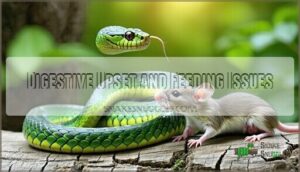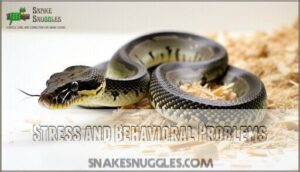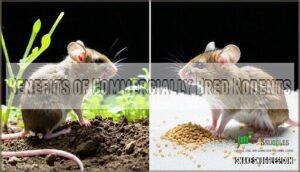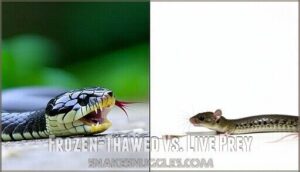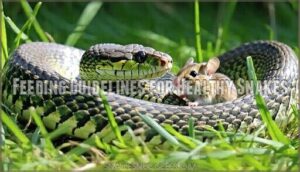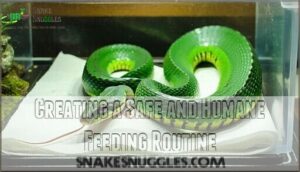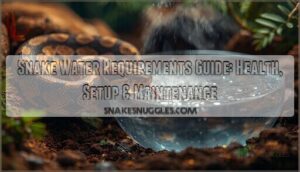This site is supported by our readers. We may earn a commission, at no cost to you, if you purchase through links.

Wild mice carry dangerous parasites, diseases, and bacteria that can make your snake seriously sick.
They might have eaten poison from pest control, which can harm your pet.
Wild mice also fight back during feeding, potentially injuring your snake’s mouth or throat.
Commercial frozen-thawed mice are much safer.
They’re raised in clean environments without parasites or toxins.
You’ll avoid expensive vet bills and protect your family from diseases that can spread from wild rodents to humans through your snake.
The smart choice is always store-bought prey – but there’s more to creating the perfect feeding routine that keeps both you and your snake healthy.
Table Of Contents
- Key Takeaways
- Can Pet Snakes Eat Wild Mice?
- Why Feeding Wild Mice is Dangerous
- Best Diet Options for Pet Snakes
- Feeding Guidelines for Healthy Snakes
- Creating a Safe and Humane Feeding Routine
- Frequently Asked Questions (FAQs)
- Can you feed wild mice to a pet snake?
- Can I leave a live mouse in my snakes cage?
- Do snakes eat rats in the wild?
- What pet snakes don’t eat mice or rats?
- How can I ensure wild mice are free of parasites and diseases?
- What are the nutritional differences between wild and commercial mice?
- What are the signs that a snake is not getting adequate nutrition?
- What temperatures should frozen mice reach before feeding?
- How long can thawed mice stay fresh?
- Can snakes eat mice from pet stores?
- Conclusion
Key Takeaways
- Don’t risk your snake’s health – Wild mice carry dangerous parasites, diseases, and bacteria that can make your pet seriously sick, leading to expensive vet bills.
- Wild mice can injure your snake – They fight back during feeding with sharp claws and bites, potentially damaging your snake’s mouth and throat.
- Choose frozen-thawed commercial mice instead – They’re raised in clean environments without parasites or toxins, providing consistent nutrition and safety.
- Protect yourself and your family – Diseases from wild rodents can spread to humans through your snake, creating public health risks in your household.
Can Pet Snakes Eat Wild Mice?
While you technically can feed wild mice to your pet snake, it’s a risky choice that can seriously harm your snake’s health.
Wild mice carry parasites, diseases, and unpredictable nutritional content that make commercially bred alternatives much safer for your pet.
Wild mice are walking disease factories that put your pet snake at serious risk
Health Risks of Wild Mice
Wild mice pose serious health risks to your pet snake.
These rodents carry parasites, diseases, and may contain wild rodenticides from environmental contamination.
Parasite resistance develops when wild prey introduces harmful organisms your snake can’t fight.
This leads to expensive veterinary costs and potential public health concerns for your household.
Parasites and Disease Transmission
Unfortunately, wild mouse parasites create serious health risks for your pet snake.
These rodents carry internal worm infections, mites, and dangerous bacteria like Salmonella.
Zoonotic disease risks mean these pathogens can spread to your snake and potentially to you.
Toxoplasmosis concerns add another layer of danger, making wild prey a risky choice for responsible snake owners.
Injury Risks From Wild Prey
Live wild mice pose serious injury risks to your pet snake during feeding.
Prey Bite Wounds from defensive rodents can damage your snake’s mouth and throat.
Wild Rodent Defense behaviors include sharp claws that cause Scratch Infections.
Trauma Severity increases when panicked mice fight back aggressively.
Zoonotic diseases can also jump from wild mice to snakes and humans.
Handling Risks multiply as you manage unpredictable, stressed animals.
Why Feeding Wild Mice is Dangerous
While you might think wild mice are free food for your snake, they’re actually walking disease factories that can make your pet seriously ill.
Wild mice aren’t free meals—they’re health hazards waiting to strike your snake
These rodents carry dangerous parasites and bacteria that commercial prey doesn’t have, turning what seems like a natural meal into a health nightmare for your snake.
Zoonotic Diseases and Parasites
Beyond the physical health risks, feeding wild mice creates serious disease transmission concerns.
Wild rodent vectors carry dangerous pathogens that can spread to both you and your snake through zoonotic transmission.
- Parasite prevention becomes nearly impossible when wild mice introduce mites, ticks, and internal worms
- Salmonella risk increases dramatically as wild mice harbor bacteria that contaminate your snake’s environment
- Toxoplasmosis threat emerges from infected wild prey, potentially causing serious illness in humans and pets
Digestive Upset and Feeding Issues
Your snake’s stomach can’t handle wild mice’s unpredictable diet.
These rodents cause regurgitation causes like bacterial overload and toxins.
You’ll notice appetite loss when your pet refuses future meals after digestive upset.
Wild prey creates impaction risks from bones and fur.
Watch for constipation signs including reduced movement.
Zoonotic diseases can also be transmitted through Zoonotic diseases.
Dietary changes from wild mice disrupt your snake’s delicate system completely, leading to digestive upset.
Stress and Behavioral Problems
Wild mice create serious stress for your pet snake. Captivity-related stress builds when snakes encounter unfamiliar prey that fights back differently than expected food.
Watch for these behavioral signs:
- Refusing meals for weeks after wild prey exposure
- Excessive hiding and defensive posturing during feeding time
- Unnatural behaviors like constant pacing or glass surfing
Environmental enrichment can’t fix the handling stress wild prey causes. Your snake needs predictable meals to thrive, and avoiding wild mice can help prevent captivity-related stress.
Best Diet Options for Pet Snakes
Now that you know the risks of wild mice, you’ll want to provide your snake with safe, healthy alternatives.
Commercial prey offers consistent nutrition and eliminates the dangers that come with wild-caught food, providing a healthy alternative.
Benefits of Commercially Bred Rodents
Commercially bred rodents offer your snake consistent nutrition and reduced parasites compared to wild prey.
Controlled breeding guarantees reliable supply and ethical sourcing practices. These rodents eat regulated diets, creating predictable nutrient profiles.
You’ll avoid the unpredictable health risks that come with wild-caught prey while supporting responsible animal husbandry standards. Whole prey options provide balanced nutritional profiles with a focus on reliable supply.
Nutritional Consistency and Quality
Lab-raised rodents offer something wild mice can’t match: predictable nutrition.
Commercial breeders use regulated diets that create consistent profiles in their rodents.
You won’t face nutrient variability or dietary imbalances that plague wild prey.
Ethical sourcing from reputable suppliers means your snake gets balanced meals every time.
Supporting healthy growth and development is crucial, and lab-raised rodents provide this consistency, ensuring your snake receives the best possible nutrition.
Frozen-Thawed Vs. Live Prey
You’ll face a tough choice between frozen-thawed and live prey.
Frozen options win hands down for safety – no Live Prey Risks like bites or scratches.
Nutrient Retention stays strong through proper Thawing Methods.
Most snakes adapt to frozen meals despite initial Snake Preference for movement.
Live feeding raises serious Ethical Implications and injury concerns for both animals.
Many owners find it convenient to source pre-killed rodents for their snakes.
Feeding Guidelines for Healthy Snakes
Getting the feeding schedule right is essential for your snake’s health and growth.
You’ll need to adjust prey size and feeding frequency based on your snake’s age and species to prevent overfeeding or nutritional gaps.
Prey Size and Frequency by Age
Proper prey sizing keeps your snake healthy and prevents problems. Young snakes need smaller meals more often than adults. Getting the size wrong can cause serious issues.
Here’s what you need to know:
- Hatchling Feeding: Feed pinkie mice every 5-7 days, matching your snake’s body width
- Juvenile Portions: Use fuzzy mice every 7-10 days, sized at 1-1.5 times snake girth
- Adult Frequency: Feed adult mice every 10-21 days based on snake size and activity
- Obesity Risks: Overfeeding leads to health problems and shorter lifespans
- Digestion Rates: Younger snakes process food faster due to higher metabolism
Safe Feeding Practices
Always use feeding tongs for prey handling to prevent accidental bites.
Source rodents from reputable suppliers, not pet stores selling live feeders.
Proper thawing requires overnight refrigeration, then warm water immersion. Consider specialized feeding equipment for safety.
Store frozen prey at consistent temperatures to maintain quality. Most snakes don’t need supplementation needs beyond whole prey nutrition.
Adjusting Diet as Snakes Grow
Your snake’s appetite grows right alongside its body. Young snakes need smaller prey every five to seven days.
Adults eat larger meals less often, maybe once every two weeks. Prey Size should match your snake’s thickest body section.
Feeding Frequency decreases with age. Dietary Supplements aren’t usually needed with whole prey.
Hydration Needs stay constant regardless of size. Shedding Impact can temporarily reduce appetite.
Creating a Safe and Humane Feeding Routine
You’ll create a feeding routine that protects both your snake and wild animals by using proper tools and commercial prey.
This approach keeps everyone safe while meeting your pet’s nutritional needs responsibly.
Using Tongs for Prey Presentation
Feeding tongs keep you safe from accidental bites. Choose steel tongs with strong grip for secure handling.
Your feeding technique affects how your snake responds to meals. For maximum safety, consider the various tong options.
- Tongs Material: Use stainless steel tongs that won’t break under pressure
- Grip Strength: Test your grip before feeding to avoid dropping prey
- Presentation Angle: Offer food from the side, never directly above your snake
- Snake Response: Watch for strike patterns to predict your pet’s behavior and avoid injury
Avoiding Wild-Caught Prey
Wild-caught rodents pose serious Wild Prey Risks that you can easily avoid.
Skip backyard hunting and choose commercial suppliers for Disease Prevention. Wild mice carry parasites and unpredictable nutrition, creating Nutritional Deficiencies.
Ethical Sourcing means supporting regulated breeders who follow health standards. Many areas have Legal Implications for collecting wild animals.
Stick with frozen-thawed options from trusted sources.
Ethical and Legal Considerations
Beyond avoiding wild-caught prey, you must examine the broader context.
Animal welfare concerns extend to all feeding practices. Local ordinances may restrict capturing wild rodents.
It’s also important to bear in mind ethical reptile ownership when choosing a pet.
Here are key considerations:
- Legal sourcing – Check regulations before obtaining any prey
- Conservation impact – Wild capture disrupts local ecosystems
- Invasive species – Transporting animals across regions spreads problems
- Animal welfare – Commercial sources follow humane standards
Frequently Asked Questions (FAQs)
Can you feed wild mice to a pet snake?
You’re playing with fire if you feed wild mice to your pet snake. They carry parasites, diseases like Salmonella, and create nutritional imbalances that can seriously harm your snake’s health.
Can I leave a live mouse in my snakes cage?
Don’t leave live mice with your snake unattended. The mouse can injure or stress your snake, especially overnight. Supervise feeding sessions and remove uneaten prey within 30 minutes for safety.
Do snakes eat rats in the wild?
Back when knights jousted for honor, you’d find snakes regularly hunting rats in nature.
Wild snakes absolutely eat rats as primary prey sources.
You’ll see this behavior across countless snake species worldwide, from small garden snakes to massive constrictors targeting large rodents.
What pet snakes don’t eat mice or rats?
You’ll find egg-eating snakes, insectivorous species like rough and smooth green snakes, and some smaller species that prefer fish, frogs, or invertebrates instead of traditional rodent prey.
How can I ensure wild mice are free of parasites and diseases?
You can’t reliably eliminate parasites and diseases from wild mice. Even thorough veterinary testing won’t catch everything. Commercial frozen-thawed mice remain the safest option for your snake’s health.
What are the nutritional differences between wild and commercial mice?
Wild mice have unpredictable nutritional content that varies by diet, season, and health status.
Commercial mice offer consistent, balanced nutrition from regulated diets, ensuring your snake gets reliable protein, fat, and vitamin levels for peak health.
What are the signs that a snake is not getting adequate nutrition?
You’ll notice weight loss, poor shedding, regurgitation, lethargy, dull colors, soft bones, stuck sheds, slow growth, and weakness.
And behavioral changes like increased aggression or hiding when your snake isn’t getting proper nutrition.
What temperatures should frozen mice reach before feeding?
Before feeding, bring frozen mice up to 98–100°F, about body temperature.
Thaw in warm water, never a microwave, to make sure they’re heated evenly.
Too cold can cause stomach issues, too hot risks burns.
How long can thawed mice stay fresh?
Studies show thawed mice spoil within 24 hours at room temperature.
You should refrigerate thawed mice and use them within 2-3 days maximum.
Never refreeze previously thawed prey, as bacteria multiply quickly in warming temperatures, which can lead to spoilage, so it is crucial to handle them properly to avoid refreeze.
Can snakes eat mice from pet stores?
Pet store mice are safe for snakes when they’re from reputable suppliers.
You’ll want to buy frozen-thawed rodents rather than live ones.
These mice are bred specifically for feeding and don’t carry the diseases or parasites that wild mice have.
Conclusion
Feeding wild mice to pet snakes might seem natural, but it puts your snake at serious risk.
Wild rodents carry parasites, diseases, and toxins that commercial prey doesn’t have. They can also injure your snake during feeding.
Store-bought frozen-thawed mice provide safe, consistent nutrition without health risks.
When you ask "can pet snakes eat wild mice," remember that they physically can, but they definitely shouldn’t for their safety and yours.
- https://rethinkpriorities.org/research-area/rodents-farmed-for-pet-snake-food/
- https://www.worldanimalprotection.us/latest/blogs/pet-store-horror-the-truth-about-feeder-animals/
- https://assets.speakcdn.com/assets/2332/humane_management_of_vertebrate_feeder_animals.pdf
- https://www.visionproducts.us/blog/frozen-vs-live-rodents-what-should-i-feed-my-snake/
- https://abdragons.com/blog/frozen-mice-and-rats-for-snake-feeding/


